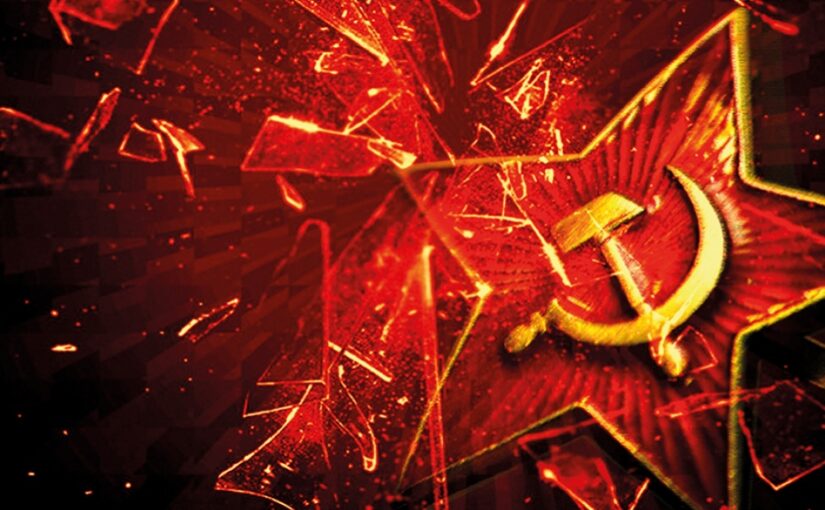This article originally appeared in the Morning Star
Thirty years ago, on 24 August 1991, President Mikhail Gorbachev dissolved the Central Committee of the Communist Party of the Soviet Union (CPSU) and resigned from his role as General Secretary. This was the first serious administrative step towards the dissolution of the Union of Soviet Socialist Republics. A day later, the Soviet flag outside the Kremlin was replaced with the Russian flag. From that moment, nothing meaningful remained of the Soviet state.
Boris Yeltsin quickly moved to ban the CPSU and to transfer its property to the Russian parliament, of which he was president. Before the year was out, the Soviet Union – the world’s first socialist state, and for seven decades the leading force of the socialist world – was erased from the map.
As far as bourgeois historians are concerned, the Soviet collapse was the natural and inevitable outcome of a misguided experiment; final proof of the all-round superiority of the capitalist system. From the standpoint of these capitalist ideologues, the dismantling of Soviet socialism was both necessary and desirable. However, from the standpoint of the Soviet workers, and indeed the working people of the world, the dismantling of Soviet socialism was entirely unnecessary and utterly disastrous.
Against the popular will
In the Soviet period, the peoples of the territories of the Soviet Union experienced an unprecedented improvement in living standards. Feudal property relations were wiped out, and the Soviet Union emerged as the second biggest economy in the world.
European fascism was defeated largely through the efforts, sacrifices, heroism and creative brilliance of the Soviet people. The world’s first welfare state was built – and indeed was the trigger for the construction of welfare states in Britain and elsewhere. Nobody that was willing and able to work went without work. Education and healthcare were comprehensive and free. Housing was often cramped, but universal and inexpensive.
The USSR led the world in dismantling systems of oppression built on race, ethnicity and gender. With the aid of the Soviet people, liberation movements around the world were able to break free from the shackles of colonialism and imperialism.
It is indisputably true however that, by the late 1980s, the Soviet Union was experiencing serious difficulties, including economic slowdown, nationalist discontent, ideological deterioration, a long and onerous war in Afghanistan, and a menacing array of hybrid warfare techniques inflicted by the US.
And yet all this had not triggered a mass movement to overthrow socialism. The dissident movement was totally marginal. Political apathy was gaining ground, true, but social revolutions (or counter-revolutions) are not born of apathy. Meanwhile there was still a lingering understanding of the extraordinary achievements made under the banner of socialism.
A sense of the popular sentiment at the time can be derived from the 1991 referendum. Facing a nationalist-separatist challenge throughout the federation, the Soviet government decided in late 1990 to hold a referendum on the preservation of the USSR (in fact this was the only referendum in Soviet history). On 17 March 1991, Soviet people across the union went to the polls to give a yes-or-no answer to the question: “Do you consider it necessary to preserve the Union of Soviet Socialist Republics as a renewed federation of equal sovereign republics, which will fully guarantee the rights and freedoms of all nationalities?”
The vote was boycotted by the governing bodies in Lithuania, Latvia, Estonia, Armenia, Moldova and Georgia, but in the rest of the country turnout was 80 percent, with 147 million total votes cast. The result was an overwhelming majority in favour of maintaining the USSR: 78 percent.
Thus just a few months before the Soviet leadership pulled the plug on the entire project, the Soviet masses clearly expressed their will to maintain the USSR. This highlights the profoundly anti-democratic character of the dissolution.
A coup, not an uprising
Workers and peasants did not provide the class basis for the dismantling of Soviet socialism. The major constituency pushing for capitalism was in fact a party-state elite – mid-level officials and enterprise managers who had taken advantage of their extensive connections and new-found economic freedoms under ‘perestroika’ to win control of assets.
Dissolution of the Soviet Union offered such people – together with the bigger players in the underground economy – the promise of a completely deregulated trade environment in which they would be able to transform their relative wealth into unimaginable wealth, albeit at the expense of the remaining 99 percent of the population.
Just as this quasi-capitalist elite was emerging, Gorbachev worked to create a political context in which it could thrive. Marxists were labelled as ‘conservatives’ and ‘hardliners’, and were sidelined at all levels of government. The national media created a political atmosphere in which any criticism of perestroika was quickly rebuked as being ‘Stalinist’.
In 1989, the Supreme Soviet was replaced as the highest body of state authority by the Congress of People’s Deputies, significantly reducing the CPSU’s formal role in governance and removing quotas for working class representation. Gorbachev mobilised to ensure a ‘pro-reform’ majority that could mandate increasingly radical reforms: closing down the central planning agencies, liberalising prices, establishing market-based trade between the republics, and forcing state enterprises to survive or die in the open market.
Price liberalisation inevitably led to speculation and inflation, which in turn exacerbated the acute shortages of everyday consumer items, in particular food. By mid-1991, with the CPSU in disarray and the economy in crisis, the confidence of the anti-socialist opposition was growing by the day. On 20 July, Yeltsin issued a decree banning the Russian branch of the Communist Party from operating in government offices and workplaces within the Russian Republic.
Seeing their country hurtling towards oblivion – and recognising that Gorbachev lacked either the will or the ability to save it – a group of high-level Soviet officials organised themselves to take control of the country and establish a state of emergency, with a view to pausing the reforms, preventing the dissolution of the USSR, and initiating a country-wide discussion on the future of the federation. These officials organised themselves under the name State Committee on the State of Emergency (SCSE).
However, the SCSE leadership developed an acute case of cold feet, dropping its plan to storm the Russian parliament and showing no willingness to use force in support of its aims. All in all, it was a thoroughly inept and half-hearted operation. As Gennady Zyuganov, leader of the Communist Party of the Russian Federation, later remarked: “If they had acted much more decisively, our unified country would have been preserved”.
Yeltsin took advantage of the situation to seize full power in Russia and make the CPSU illegal. As Roger Keeran and Thomas Kenny write in their book ‘Socialism Betrayed’, “that was the real coup.”
A historic setback
Gorbachev resigned as president on 25 December 1991. With no legal precedent or constitutional framework, Yeltsin simply transferred the Soviet state bodies and property to Russia, and on 31 December, the Soviet Union formally ceased to exist.
In the ensuing four years, Russian life expectancy fell from 65 to 57 – unprecedented in times of peace. The previously impressive healthcare infrastructure collapsed and the peoples of the former Soviet Union were subjected to epidemics of poverty-fuelled diseases not seen for many decades. It took around 15 years for Russian GDP to recover to 1990 levels – during which period China’s GDP had increased more than three-fold.
The tragedy reverberated around the world. As Fidel Castro noted, “the destruction of socialism in the USSR … inflicted terrible damage on all peoples of the world and created a bad situation for the Third World in particular.”
The collapse of the Soviet Union and European socialism could reasonably be described as the worst defeat suffered by the global working class in its history. It gave a lifeline to imperialism and set back the cause of human liberation by several decades.
Thirty years later, however, it is clearer than ever that capitalism cannot solve the problems faced by humanity. Meanwhile, the socialist world continues to make impressive advances, the most immediate example being its vastly superior performance in the face of the coronavirus pandemic.
The socialist countries, parties and movements of the world continue to take inspiration from the heroic Soviet people, who built the first socialist society, led the defeat of fascism, and laid the ground for a future of peace, solidarity and prosperity.


Dissolving the USSR was also a completely illegal and unjustifiable political act.
Just wondered Carlos, how do you explain all the revolutions in Eastern Europe? Doesnt that indicate that things wernt that great there?
Thankful for answer.